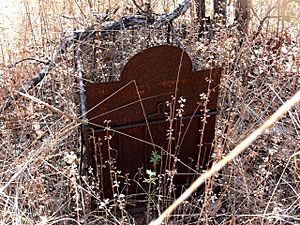Station Creek Cemetery facts for kids
Quick facts for kids Station Creek Cemetery |
|
|---|---|

Fenced grave at Station Creek Cemetery, 2009
|
|
| Location | Normanton Road, Croydon, Shire of Croydon, Queensland, Australia |
| Design period | 1870s - 1890s (late 19th century) |
| Built | c. 1899 |
| Official name: Station Creek Cemetery, Golden Gate Cemetery | |
| Type | state heritage (built) |
| Designated | 25 October 2002 |
| Reference no. | 602375 |
| Significant period | 1890s-1920s (fabric) c. 1899-1920s (historical use) |
| Significant components | burial/grave, grave surrounds/railings, grave marker |
| Lua error in Module:Location_map at line 420: attempt to index field 'wikibase' (a nil value). | |
The Station Creek Cemetery is a historic burial ground near Croydon, Australia. It is also known as Golden Gate Cemetery. This cemetery was officially opened around 1899. It is an important part of Queensland's history, showing what life was like during the gold rush era. The cemetery is listed on the Queensland Heritage Register.
Contents
History of the Goldfield
Discovering Gold in Croydon
Croydon became a very important goldfield in 1886. It was one of the last big gold rushes in North Queensland during the 1800s. The area was first explored by Europeans in the 1860s. Gold was found on Croydon Downs Station in 1883 by James and Walter Alldridge, who worked for W.C. Brown. More gold was found in 1885, and the area was officially declared a goldfield in January 1886.
Croydon's Gold Rush Boom
By 1887, about 7,000 people lived in the Croydon area. It was one of the biggest towns in North Queensland. From 1890 to 1910, Croydon produced the second most gold in Queensland, after Charters Towers. Over time, more than 772,000 ounces of gold were found here.
Life and Challenges in the Goldfields
Life in the Croydon goldfields was tough. People often struggled with not enough water, food for animals, or wood for building. Being far away from other towns was also a big problem until the railway to Normanton was finished in 1891. The area also faced droughts, floods, and even a cyclone in 1906.
Workers sometimes had disagreements about their pay. There was also a diverse community, including Chinese, Cingalese, Malays, and African people. The Chinese community was especially important for growing food in market gardens, which helped everyone in the town.
Growth of Croydon Town
Despite the difficulties, the 1890s were busy years for Croydon. By 1900, the town had many businesses, including banks, bakers, chemists, and 18 hotels! Croydon became a municipality in 1892, meaning it had its own local government.
Many smaller towns grew up around Croydon, like Golden Gate, Tabletop, and Gorge Creek. People from these smaller places would come to Croydon on Saturday nights to shop and meet friends. Because there were so many small communities, at least 10 cemeteries were set up across the district.
The Golden Gate Township
The town of Golden Gate was surveyed in 1892, but buildings were there even earlier. It became a very productive gold area after 1891. By 1900, Golden Gate had about 600 people, 11 hotels, and 3 churches. It even had a school and a post office. However, gold production slowed down before World War I, and the town mostly disappeared after 1922.
About Station Creek Cemetery
Why So Many Cemeteries?
Station Creek Cemetery is one of many cemeteries that served the Croydon goldfield. It was officially named the Golden Gate Cemetery in 1900 after a survey in 1899. It covers about 1 hectare of land. This cemetery is about 2 to 3 kilometers southeast of where the Golden Gate town used to be.
There was an earlier burial ground closer to the Golden Gate town, also often called the Golden Gate Cemetery. This older cemetery was never officially registered. It seems people used it until the Station Creek Cemetery was opened. It is thought the new cemetery was placed between two important mining areas, Golden Gate and Sunset, so it could be used by both communities.
What You Can See Today
Today, there are two clearly marked graves at Station Creek Cemetery. One of these graves belongs to a young girl named Charlotte Brown. Her grave has a metal railing around it. There is also evidence that about 34 other people were buried here.
The cemetery is surrounded by natural plants and trees. You can reach it from Normanton Road. The ground is gently sloped with sandy soil. Many native trees and grasses grow here, providing a home for local birds and animals.
Why This Place is Important
A Look into the Past
Station Creek Cemetery is important because it shows us how Queensland's history unfolded. It helps us understand what life was like for the people who lived and worked in the Croydon goldfields. By studying the graves, we can learn about the different groups of people, their jobs, and their social standing in the early community.
Learning from the Graves
This cemetery can teach us a lot about the early settlers of Croydon. It gives clues about their backgrounds, including where they came from and their beliefs. The graves also show the challenges and hardships faced by the first people who lived in this gold mining area.
Special Meaning to the Community
The Station Creek Cemetery has a strong spiritual and symbolic meaning for the community. It is a place where early residents were laid to rest. It reminds us of the tough lives and hard work of the people who helped build the Croydon goldfield.
Images for kids


